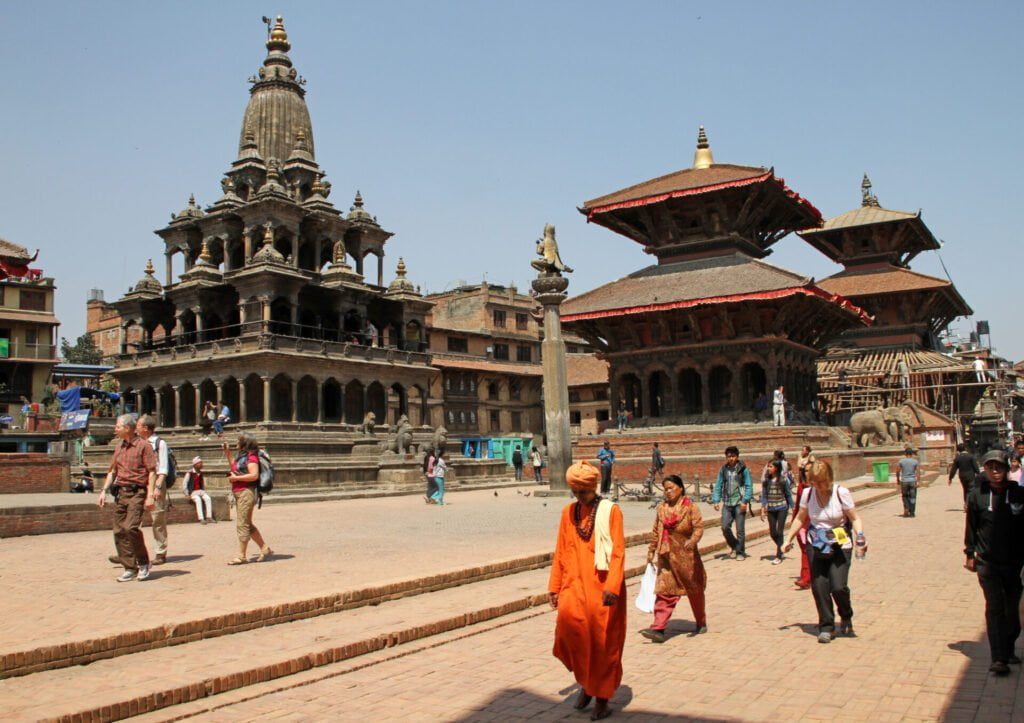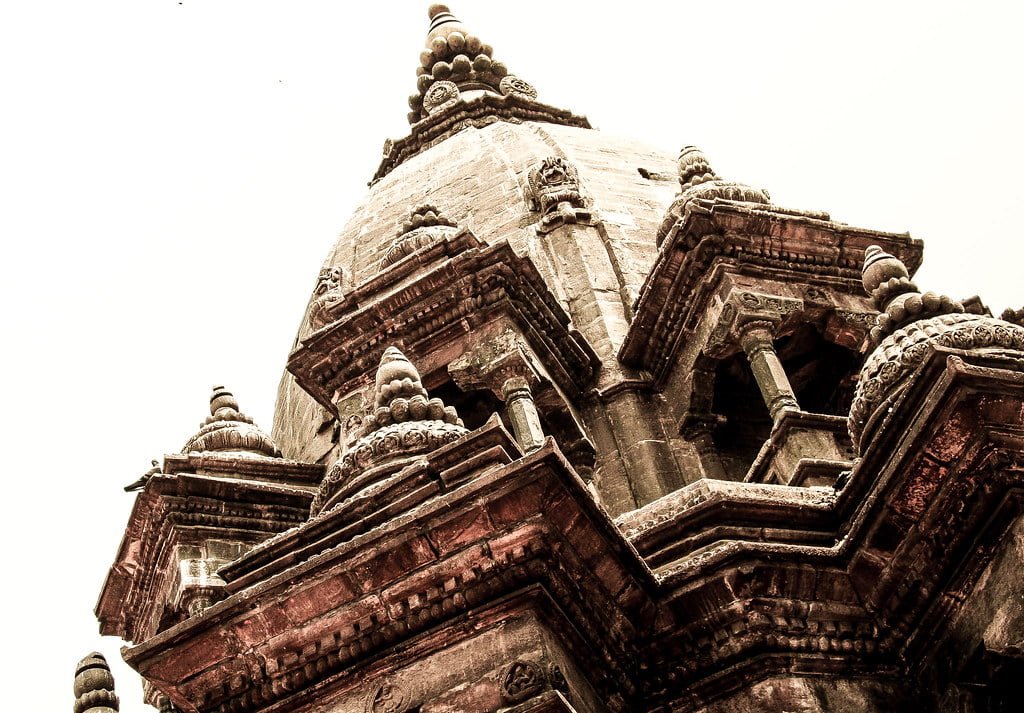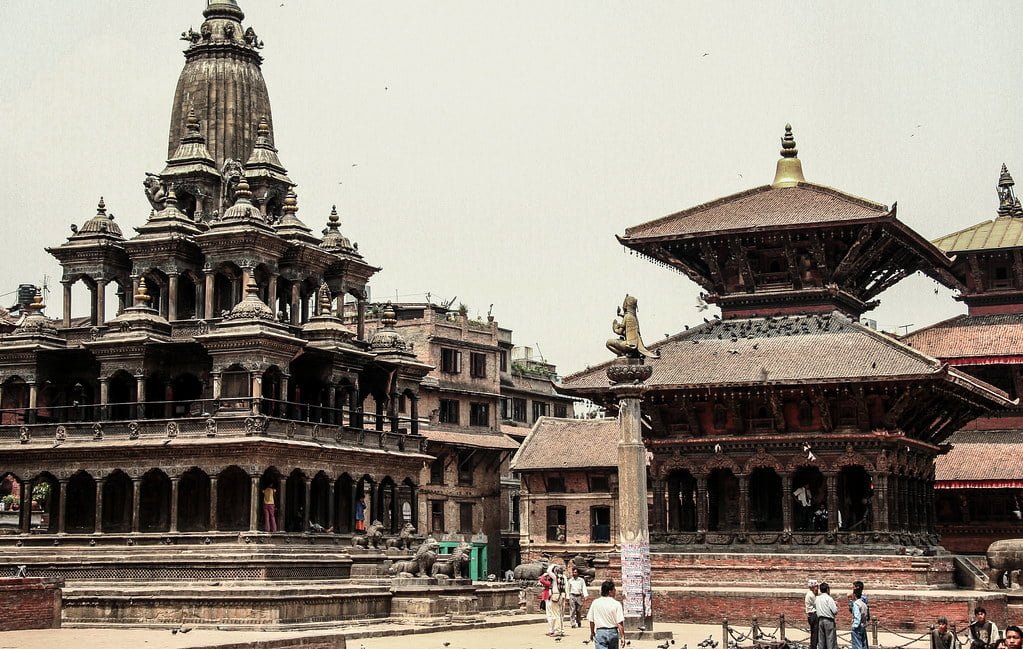Krishna Mandir, Patan: A Historical and Spiritual Gem
Located in Patan, Nepal, Krishna Mandir is a 17th-century temple that holds great historical and religious significance. Built by King Shikhara, this temple is an iconic example of traditional Nepalese architecture and serves as a place of worship for Hindus.
The temple is dedicated to Lord Krishna, a revered deity in Hinduism. Lord Krishna is considered the eighth avatar of Lord Vishnu and is known for his divine teachings and heroic deeds. The Krishna Mandir is a testament to the devotion and reverence of the Nepalese people towards this beloved deity.
Over the centuries, the Krishna Mandir has witnessed various renovations and restoration projects to preserve its architectural beauty and cultural heritage. However, it faced significant damage during the devastating earthquake in Nepal in 2015. The restoration efforts have been ongoing since then, and the temple has once again opened its doors to pilgrims and visitors.
The Krishna Mandir is a visual delight, with intricate carvings and sculptures adorning its walls and pillars. The temple’s design reflects the traditional style of Nepalese pagoda architecture, characterized by its multi-tiered roofs and ornate embellishments. The vibrant colors and detailed craftsmanship make it a captivating sight for all who visit.
Devotees flock to the Krishna Mandir to offer their prayers and seek blessings from Lord Krishna. The temple holds special significance during festivals like Janmasthami and Holi when devotees gather in large numbers to celebrate and express their devotion. These occasions are marked by colorful decorations, music, dance, and religious rituals, creating a vibrant atmosphere of joy and spirituality.
The Krishna Mandir is not just a place of worship but also serves as a symbol of Nepal’s rich cultural heritage. It stands as a testament to the unwavering faith and devotion of the Nepalese people towards their gods and goddesses. The temple’s historical and architectural significance attracts tourists and art enthusiasts from around the world, who marvel at its beauty and soak in the spiritual ambiance.
Visiting the Krishna Mandir in Patan is a profound experience that allows one to connect with the rich history and religious traditions of Nepal. Whether you are a devout Hindu seeking spiritual solace or a curious traveler eager to explore the cultural gems of the country, the Krishna Mandir offers a glimpse into the vibrant tapestry of Nepal’s religious and architectural heritage.
Historical Significance of Krishna Mandir
The Krishna Mandir holds immense historical significance as a place of worship for Hindus in both Hartford, Connecticut and Rawalpindi, Pakistan. Its establishment and subsequent preservation over the years have played a vital role in preserving and propagating the rich traditions of Sanatan Dharma.
In 1897, the Krishna temple in Rawalpindi was built by Kanji Mal and Ujagar Mal Ram Rachpal, two prominent businessmen of Saddar. This sacred place of worship was intended to cater to the spiritual needs of the Hindu community residing in the surrounding areas. The temple served as a symbol of religious harmony and tolerance, providing a safe space for Hindus to worship freely.
However, during the tumultuous period of 1947 to 1948, the temple was temporarily closed to prevent religious violence that ravaged the region. Despite this setback, the Krishna Mandir continued to hold a special place in the hearts of the Hindu community. In 1970, the temple faced yet another challenge when it was taken over by the Evacuee Trust Property Board, resulting in the occupation of the temple land by local traders. The Hindu community has since been actively protesting against this occupation, seeking the restoration of their sacred site.
In Hartford, Connecticut, the Shri Krishna Mandir was established in 1997 by a group of individuals dedicated to providing a safe and inclusive space for Hindus to worship according to the Vedas and Puranas. The Mandir has fulfilled its purpose of safeguarding and propagating Sanatan Dharma, while also serving as an educational hub for Hindu scriptures and traditions. It has played a pivotal role in educating children and future generations about their faith and cultural heritage.
Both the Krishna Mandir in Rawalpindi and the Shri Krishna Mandir in Hartford hold great historical significance in preserving and promoting Hindu traditions. These temples are not only places of worship but also symbols of resilience, unity, and the unbreakable spirit of the Hindu community. Their historical significance lies in their ability to provide a sense of belonging, spirituality, and cultural identity to Hindus in their respective communities.
The ongoing efforts to restore the Krishna Mandir in Rawalpindi and the continuous dedication of the Shri Krishna Mandir in Hartford are testaments to the historical significance of these sacred places. They serve as reminders of the enduring strength and perseverance of the Hindu community in upholding their religious beliefs and traditions.

Religious and Cultural Importance
Symbolism and Secular Imagery
The Rani-ki-Vav, also known as The Queen’s Stepwell, at Patan, Gujarat, is not only a remarkable architectural marvel but also a treasure trove of symbolism and secular imagery. This magnificent stepwell, designed as an inverted temple, showcases the sanctity of water and the rich cultural heritage of the Maru-Gurjara architectural style.
The stepwell is divided into seven levels of stairs, each adorned with sculptural panels of exceptional artistic quality. These panels depict a wide range of religious, mythological, and secular imagery, often referencing literary works. More than 500 principal sculptures and over a thousand minor ones combine to create a visual narrative that captivates the imagination of visitors.
Religious and mythological symbolism abound in the intricate carvings of gods, goddesses, and celestial beings. These sculptures not only serve as decorative elements but also convey profound messages and convey religious teachings. The inclusion of mythological figures and scenes adds a sense of grandeur and spiritual significance to the stepwell.
In addition to religious iconography, the Rani-ki-Vav also incorporates secular imagery, representing aspects of everyday life. These secular motifs provide a glimpse into the social, cultural, and historical context of the time. Scenes depicting courtly life, dance performances, music, and various professions reflect the vibrant and diverse society of the period.

Artistic Quality and Elaborate Multi-Storey Works
One of the most impressive aspects of Rani-ki-Vav is its artistic quality and elaborate multi-storey works. This stepwell showcases the pinnacle of craftsmanship and architectural excellence during the Maru-Gurjara architectural style. Its intricate design and attention to detail reflect the mastery of the craftsmen who created it.
Rani-ki-Vav is divided into seven levels of stairs, each adorned with sculptural panels of high artistic quality. These panels feature more than 500 principal sculptures and over a thousand minor ones, depicting a blend of religious, mythological, and secular imagery. Many of these sculptures reference literary works, adding another layer of cultural significance to the stepwell.
The fourth level of Rani-ki-Vav is particularly noteworthy, as it is the deepest and leads to a rectangular tank at a depth of 23 meters. This level showcases the ingenuity of the architectural design, with a well located at the westernmost end of the property. The well consists of a shaft 10 meters in diameter and 30 meters deep, further highlighting the complexity and scale of this water management system.
What sets Rani-ki-Vav apart is not only its architectural structure and technological achievements in water sourcing and structural stability but also its sculptural decoration. The figurative motifs and sculptures, along with the balance of filled and empty spaces, contribute to the stepwell’s unique aesthetic character. The setting of the stepwell enhances these attributes, as it descends suddenly from a plain plateau, creating a dramatic and awe-inspiring space.
Rani-ki-Vav is an exceptional example of artistic mastery, showcasing the fusion of architecture and sculpture. The intricate details and elaborate multi-storey works demonstrate the immense skill and creativity of the craftsmen involved in its construction. Its artistic quality and aesthetic value make Rani-ki-Vav a true masterpiece of Indian heritage and a testament to the rich cultural history of the region.
Near by Tourist Attractions
Patan Durbar Square: A Glimpse into Ancient Newari Architecture and Culture
Patan Durbar Square, located in the heart of the city of Patan, is a captivating display of Newari architecture and a testament to the rich cultural heritage of Nepal. Once the palace of the kings of Patan, this square is a harmonious blend of palace buildings, artistic courtyards, and graceful pagoda temples.
As you approach the square from the south side, the magnificent palace stands on your right, while a series of temples adorns the left. The square is a bustling hub of activity, where the sound of craftsmen tinkering with statuettes fills the air. The streets are lined with brick houses, and the atmosphere is vibrant with the presence of well-preserved Hindu temples, Buddhist monasteries (vihars), and other historical monuments.
Similar to its counterpart in Kathmandu, Patan Durbar Square is a UNESCO World Heritage Site that showcases the pinnacle of Newari architecture during the reign of the Malla kings. The square’s numerous courtyards offer a glimpse into the opulence and grandeur of the past. One such courtyard, the Keshav Narayan Chowk, has been converted into a bronze artifact museum, where visitors can marvel at exquisite sculptures and artifacts.

Rani ki Vav Stepwell: A Jewel of Ancient Architecture
Rani ki Vav is a remarkable stepwell located in the town of Patan in Gujarat, India. This intricately constructed structure is a testament to the architectural brilliance and artistic finesse of ancient India. It is situated on the banks of the Saraswati River, which, although now dried up, was once a seasonal river.
The stepwell was built during the 11th century AD by Queen Udayamati in memory of her husband, King Bhimdev I of the Solanki dynasty. Rani ki Vav, which translates to “the Queen’s stepwell,” was designed as a monument to honor the king’s memory and to serve as a resting place for travelers and pilgrims.
The stepwell is a marvel of engineering and craftsmanship, with its intricate carvings, grand pillars, and elaborate ornamentation. It is divided into seven levels, with each level adorned with sculptures depicting various mythological and historical scenes. The walls of Rani ki Vav are adorned with more than 800 intricate sculptures, showcasing the mastery of the artisans of that era.
Patan Museum: Exploring the Rich Cultural Heritage of Nepal
Located in the charming city of Patan, Nepal, the Patan Museum is a must-visit destination for art enthusiasts and history buffs. This renowned museum is housed within the Patan Durbar Square, a UNESCO World Heritage Site, and showcases a remarkable collection of artifacts that provide a fascinating insight into the rich cultural heritage of Nepal.
The museum, which was heavily damaged during the earthquake in April 2015, has since been restored and reopened to the public. It boasts over 1,100 artifacts, including a vast collection of sculptures of Buddhist and Hindu deities. These intricately crafted sculptures serve as a testament to the exquisite craftsmanship of the Nepali artists throughout history.
One of the highlights of the museum is the Golden window, an exquisite architectural feature that impresses visitors with its intricate design and golden hue. The Golden gate, another notable attraction, welcomes visitors into the museum with its grandeur and opulence. These architectural marvels are a testament to the artistic and architectural prowess of the Newar artisans, who have played a significant role in shaping the cultural landscape of Patan.
In addition to the artifacts on display, the Patan Museum complex also features three beautiful courtyards. One of these courtyards, Sundari Chowk, lives up to its name, as it exudes beauty and tranquility. At the center of Sundari Chowk stands the Tusha Hiti, a structure adorned with stone carvings and a bronze spout featuring the Hindu gods Vishnu and Laxmi on a Garuda, symbolizing Lord Vishnu’s mythical bird.
